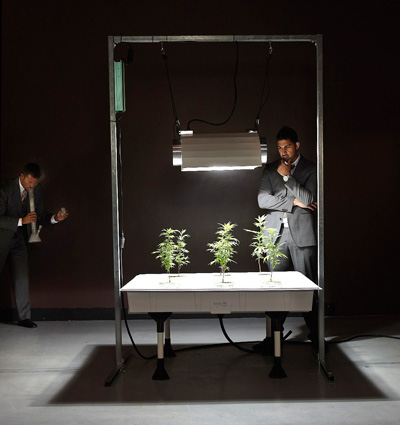
Photographs by Chris Buck
Read about the new ganja service industry, test your medical marijuana knowledge with our quiz, or see the full Mother Jones special report on the coming pot boom.
ON A SUNDAY IN EARLY OCTOBER, Dhar Mann threw a party at weGrow, his hydroponic marijuana superstore in Oakland, California. Trailed by a three-person video crew from Hempire, the reality-show pilot he’s costarring in, Mann gave sound bites to a pack of reporters as he strutted past Ikea-style displays showcasing products for every stage of indoor cannabis cultivation—from Sun Pulse lightbulbs to $700 grow tents and Bud Candy plant nutrients. “It’s the whole supply chain,” said the fauxhawked 26-year-old, self-assured in a tailored gray suit and red silk tie.
Mann stopped to talk to a wholesaler who said his bongs would nicely complement the West Elm couches, hardwood coffee tables, and Afghan rugs decorating weGrow’s cozy smoking paraphernalia showroom. “I want a whole variety of products like this,” Mann told the bong guy enthusiastically, “because that’s what makes us different from any other hydro store.”
Two years ago, Mann says, he had never seen a pot plant. Today, he envisions weGrow becoming the “Wal-Mart of Weed,” a vertically integrated chain of big-box stores perfectly positioned to cash in on California’s booming marijuana industry as it moves from the shadows to the mainstream. In this “green rush” for semi-legal weed, Mann and his partner Derek Peterson, a 36-year-old investment banker, seek to be the modern equivalents of Levi Strauss and Samuel Brannan—the Gold Rush entrepreneurs who made a killing not from mining, but from selling pans, pickaxes, and victuals to the forty-niners.
“Derek and I have really thought about how we can capture the entire market segment,” Mann says. Since it opened a year ago in a 15,000-square-foot warehouse near the Oakland International Airport, weGrow has aggressively tried to cover as many angles as possible: It trains aspiring medical marijuana growers at its University of Cannabis (the “Princeton of Pot”); manufactures its own brand of indoor growing gear (GrowOp); dispatches its hydroponics experts on house calls; and keeps a doctor onsite to write medical marijuana recommendations. Mann and Peterson say they’ve signed contracts to open 75 franchise stores in California, Oregon, Arizona, Colorado, and Illinois, and they’re talking up an IPO later this year.
Like Mann and Peterson, Oakland has come to embrace the financial side effects of medical marijuana. The city recently approved a package of permits and taxes for pot-related businesses that it estimates could bring in more than $10 million annually. WeGrow has already caught the eye of local politicians, including Jean Quan, a city council member who was elected mayor in November. On a stage outside the warehouse, Quan commended the company: “I want to congratulate Derek and Dhar. And I want to say that this is just probably the first step in California and perhaps the rest of the nation.”
Afterward, Peterson scrolled through messages on his BlackBerry while Mann chatted with city council member Desley Brooks. Since 2009, Mann and his employees have donated $4,300 to Quan and three other council members including Brooks, who recently signed on to a proposal to have the city issue permits for large-scale growing operations. I asked her what criteria the council would use to pick Oakland’s most reputable cannabis entrepreneurs. She laughed as Mann cut in, “Tall, good-looking, handsome.”
As Mann threaded his way through a throng of cameras, a dreadlocked guy who described himself as a maker of “strong herbalizations” handed him a business card the size of a pat of butter. (“We’re saving trees.”) Mann politely slipped the card into his wallet, but looked wary as he walked away. “It’s so important not to alienate these guys,” he said. “At least hear them out and give them a fair chance.” The older generation of pot impresarios, he continued, “are brilliant scientists, but they are not such brilliant businessmen. That’s where Derek and I can come into play, because we understand both sides.”
THE EUREKA MOMENT for the new pot economy was the November 1996 passage of California’s Proposition 215, a loosely worded ballot measure that gives anyone who can obtain a doctor’s recommendation the legal right to consume marijuana. Enabled by a cottage industry of MDs offering discount scrips for just about anything worse than a hangnail, as many as 400,000 Californians now have carte blanche to get high. (See “Stoned in 90 Seconds.”) An estimated 1,000 medical marijuana dispensaries sell strains of designer weed like Grand Daddy Purple and Afghani Goo, which can be smoked, vaporized, or ingested in edibles ranging from old-fashioned pot brownies to ganja-infused beef jerky. Last year’s sales of medical marijuana in California topped $1.3 billion (PDF).
In many respects, the semi-legit marijuana market resembles the early days of the internet bubble, where start-ups helmed by young entrepreneurs with risky business plans sought venture capital and dreamed of stock offerings. Where dot-coms had server farms, the pot-coms have high-tech “grow ops”—indoor farms of wires, fans, and coiled air ducts that keep genetically selected, cloned pot plants growing 24/7. Growers have colonized Oakland’s abandoned and foreclosed houses; Mann and Peterson have dubbed the electricity-sucking boomtown “Grass Valley.”
The marijuana stampede has also spurred a host of high-tech services and spinoffs, from pot-locator and price-comparison iPhone apps to grow-house monitors. (See “Green Jobs.”) BR Merchant Service processes dispensaries’ credit card purchases, working with an anonymous bank that doesn’t mind handling pot transactions. And where the first tech millionaires had Wired, the new “ganjapreneurs” have the San Francisco-based Rosebud, a glossy with ads for $24,000 computerized hydroponics systems and $230,000 Bentleys. Last September’s issue featured Weeds star Mary-Louise Parker on the cover.
The mainstreaming of California’s largest cash crop, worth $14 billion annually, has sparked a battle for market share. Marijuana dispensaries have traditionally sourced much of their supply from the Emerald Triangle, a trio of far Northern California counties whose main appeal to growers is its rough terrain, which keeps DEA agents at bay. Yet cannabis aficionados are increasingly demanding strains with unique flavors and powerful psychoactive qualities that are most easily bred in hothouses. Hydroponic weed sells for a 50 percent premium over outdoor strains, which has allowed both varieties to coexist. But the NorCal farmers fear that legalization would enable their urban competitors to move out of garages and closets and into warehouses, driving down prices and pushing them out of business. They fiercely opposed Proposition 19, the unsuccessful November ballot measure that would have legalized marijuana for recreational use in California. All three counties of the Emerald Triangle, including liberal Humboldt and Mendocino, voted against it.
“The irony is that the people who made the Emerald Triangle industry, they got into the business because it wasn’t a job,” says Hank Sims, editor of the North Coast Journal, an alt-weekly in Eureka, California. To survive in the new economy, the old yeoman growers “have to get out and hustle.” That means “they have to actually be in the system, where the whole appeal in the past was being out of the system. They have to suit up and go around with a sample case from club to club. And that’s going to be hard for people to put their head around.”
 Derek Peterson (left) and Dhar Mann (right) with one of weGrow’s hydroponic growing units.
Derek Peterson (left) and Dhar Mann (right) with one of weGrow’s hydroponic growing units.
Which is where the new breed of pot entrepreneurs comes in. “Because the industry’s moving from the black market into the light, there are just so many different ways that money can be made,” says David Abernathy, the director of Compassionate Green Financial Services, a venture-capital firm that advertises a staggering 80 percent average annual return on its marijuana-based investments. A former investment-bank analyst, he claims to have sunk more than $1 million (he won’t disclose the precise amount) into pot dispensaries, delivery services, and grow ops. Half of it, he says, was raised from hedge fund managers and other professional investors. For investors with a high tolerance for uncertainty, the quasi-legal status of the pot business is a huge opportunity, he says, since it’s allowing “small businesses to get a foothold before the big Philip Morrises jump into the game.”
Those who are bullish on pot note that 15 states now allow some form of medical marijuana use. The Justice Department has said it will no longer raid medical marijuana dispensaries, as it did during the Bush administration. Forty-six percent of Californians voted for Proposition 19—more than voted for Republican candidates for governor or senator—proving that pot legalization is no longer a fringe cause. Marijuana activists say it’s only a matter of time before the law catches up with Americans’ softening attitudes toward pot and the realization that regulating it could fill empty state and local treasuries. In October, California downgraded the possession of an ounce or less of pot from a misdemeanor to an infraction, the equivalent of a speeding ticket. Pot activists are talking about getting legalization initiatives on the ballot in Colorado, Washington, Nevada, and California (again) in 2012.
Yet for the paranoid, there are still plenty of reasons for caution. Last fall, Attorney General Eric Holder warned that while he’d tolerate medical marijuana, he would continue to “vigorously enforce” federal drug laws against anyone who dares to “possess, manufacture, or distribute marijuana for recreational use.” Which is why Abernathy, the venture capitalist, tries to give his investors plausible deniability by financing his pot companies through a web of holding and servicing firms. “We have spent many, many hours with many, many lawyers coming up with ways to protect ourselves,” he says.
The weGrow guys have consulted with attorneys, too, and they came away unfazed. “You throw four lawyers in the room, and they all have a different opinion,” Peterson scoffs.
Besides, when your business plan depends on publicity, there is no upside to playing it safe. The promo for Hempire, which Mann and Peterson financed themselves, features an image of the duo in suits, flanking a giant marijuana leaf cut from a $100 bill. It has all the elements of a hit: the cocky front man, the calculating numbers guy, and Lindsay, their attractive, put-upon executive assistant. “I personally have always wanted a reality show ’cause I just think that my life is somewhat appealing to watch,” says Mann. The show’s pilot was filmed by A-Team director Joe Carnahan, and Mann and Peterson say they’re in negotiations with the production company behind Deadliest Catch. “It’s a hedge,” Peterson explains. “If we screw everything up in our personal lives and our businesses go down the drain, they’re gonna love that in TV land!”
A financial consultant for medical marijuana investors, growers, and sellers, who didn’t want his name used, says the weGrow guys “are cocky and pushing too hard, too fast.” With their in-your-face attitude, they might get raided, snarled in red tape, or written off as blowhards. “In a lot of ways they are stumbling around in the dark. But,” he adds, “it’s not implausible that something amazing would come out of it, because they have the public-relations apparatus, the money, and the balls to surge forward.”
THE SEEDS for weGrow were planted in early 2009, when Dhar Mann received a visit at his property-management firm from a tenant whose office had just been burglarized. Mann was about to call the cops when the tenant confessed that he wasn’t actually a caterer, as he’d claimed on his lease. He was a medical cannabis grower, and he’d been using his space to cultivate six dozen plants.
The notion of being a landlord for pot growers intrigued Mann, the scion of Oakland’s largest taxicab company, who’d founded a mortgage refinancing mill and a luxury-car rental company before he’d turned 25. He paid $500 to enroll in courses at Oaksterdam University, started in 2007 by longtime legalization advocate Richard Lee to provide technical and legal training to would-be growers. Looking at the old-school potheads studying at “America’s first cannabis college,” Mann realized he could fill a niche. “Everybody I was meeting was a little bit older, more a part of the hippie generation,” he recalls. “I was like, ‘I bet there’s so much room for innovation and new ideas.'”
His first enterprise was igrow420.com, a kind of Facebook for potheads that never took off. Undeterred, he rented a giant warehouse (from his dad) and prepared to become a grower. When he walked into a hydroponics store in Berkeley and asked how to start a pot farm, the salesman kicked him out. A federal ban on selling pot paraphernalia and comedian Tommy Chong’s 2003 imprisonment for selling bongs have scared most hydro shops into avoiding any mention of marijuana.
That’s when Mann switched gears again: He’d create “the first honest hydro store,” one that didn’t perpetuate the charade that its customers are spending thousands of dollars growing amazing tomatoes. When the PR shop that was managing weGrow’s grand opening in January 2010 handed him a press release that read “Urban gardening megastore opens by airport,” Mann fired the firm and rewrote the release himself: “Marijuana Superstore Opens in East Oakland.”
Early on the morning of the opening, Mann’s brother phoned to say that someone kept calling him from a blocked number, claiming to be waiting outside weGrow. Fearing that it was vengeful drug-world competitors, Mann called the police and sped over in his orange Lamborghini Gallardo. Instead, he found a TV news crew. Just hours after the store opened its doors, Mann’s wholesale hydroponics supplier called to say he would no longer sell to weGrow because it had violated the hydroponics code of silence. Mann started quietly buying merchandise from retail hydro stores and sold it at a loss just to keep his shelves stocked.
Mann says he acquired his nose for business from his father, who’d been a farmer in Punjab before coming to Oakland in 1985 and buying a cab. Now he owns 200 of them. But Mann says his dad is less than impressed with his return to the family’s agricultural roots. “He’s very worried,” Mann told me. “All the time.”
As Mann was getting weGrow off the ground, Derek Peterson was managing a $100 million investment portfolio at Morgan Stanley in Orange County and dabbling in the pot business on the side—growing weed in his garage and brokering pot sales to dispensaries. He was also working on converting an eight-wheel trailer into a mobile WMD lab of a pot farm known as the Big Bud (motto: “Size DOES Matter”). He approached weGrow’s Grow Squad (later renamed Bloom Room after Best Buy claimed the name infringed on its Geek Squad tech-support service) for technical advice and came away impressed.
Mann eventually proposed a deal: Peterson’s company, GrowOp Technology, would manufacture hydroponics equipment and sell it to weGrow. Then he and Peterson would take stakes in each other’s businesses with the ultimate goal of taking GrowOp public on Wall Street.
Peterson agreed and moved up to Oakland. While Mann roped in a family friend to broker manufacturing contracts in China, Peterson mined his Rolodex at Morgan Stanley, where he was still employed as a senior vice president in its Irvine office. (A Morgan Stanley spokeswoman asked that I not mention Peterson’s employment at the firm. Shortly after this conversation, Peterson told me he was headed to Orange County to do damage control. He said he’d already been planning to leave Morgan Stanley at the end of the year.)
Peterson claims that Grow-Op was an easy sell to potential investors, largely because it could offer a seriousness and business savvy that its competition couldn’t. If everything works out as Peterson and Mann insist it will, GrowOp’s projected $2 million in annual profits will give it a $50 to $60 million market cap when it goes public later this year. Together they will own 70 percent of the shares. That’s small change compared with a tech IPO, but if it actually happens, it would add to weGrow’s legitimacy in the eyes of investors, regulators, and potheads.
One Saturday a couple of weeks before the weGrow bash, I caught up with Mann and Peterson at the International Cannabis and Hemp Expo just south of San Francisco. It was 4:20 p.m., and they had procured strawberry-banana-marijuana smoothies from two of the many scantily clad young women sauntering through the hall offering all manner of pot-infused goodies. “I consume the least out of everybody,” Mann told me. “Most of my staff has never even seen me smoke.” Peterson worried about his smoothie’s high THC levels: “They always scare me when they say, ‘We’ve been making them stronger and stronger.'”
The afternoon’s big event was a debate between pro- and anti-legalization potheads that quickly went sour, as chants of “You suck!” clashed with cheers and applause. “I’m hiding behind you if a fight breaks out,” Peterson told me. “I’m too stoned to throw punches.” I pointed out that pot smokers are supposed to be peaceful. “I’m telling you, man, when economics gets involved, it changes everything,” he replied. A year from now, he predicted, the pot business “is gonna be as ruthless as Wall Street.”
He and Mann headed over to a table selling Doob Tubes, pocket-size airtight joint containers. “Everybody knows Doob Tubes,” Peterson said before moving in to see if the Doob Tubes guy would cut him a deal on volume. “I only sell it at one price, and it’s at wholesale,” Ray C., the inventor and owner, informed him firmly. Peterson asked what the price would be if weGrow ordered 200,000 tubes—a shipment 20 times the size of a typical order. Ray C. laughed. “That would be a much different price.”
SIZE DOES MATTER. Mann and Peterson know the real money isn’t in being the biggest seller of Doob Tubes. Which is why they still have their eye on the mother lode of California’s green rush. Oakland is planning to offer four industrial-scale marijuana farming permits, and the weGrow guys hope that their new cannabis cultivation arm, GROPECH (Grass Roots of Oakland Philanthropic and Economic Coalition for Humanity), can snag one. They envision a 60,000-square-foot, solar-powered warehouse that would hold 30,000 cannabis plants yielding $50 million worth of buds per year. Though Oakland would require the farms to be not-for-profit, “My feeling is that eventually they’ll turn that into a for-profit entity down the line,” Peterson says. “We could, 20 or 30 years from now, be the Budweiser of marijuana.”
Late on a Tuesday night, Mann and a couple of weGrow employees sat in his bachelor pad in downtown Oakland, passing a glass pot pipe. On his widescreen TV, the city council was debating how to assign the grow permits. “It’s like watching the Super Bowl for me,” Mann said between hits. He perked up when a council member suggested that the farms be required to purchase 80 percent of their equipment locally; that could be huge for weGrow.
“There’s so much politics involved,” he said after changing out of his suit and into a white hoodie. “It’s like a game of chess, man. The thing that you have to keep in mind is that you’ve got a lot of pieces before you get to the king, right? And any one of those can be a game changer.”
After an hour, the council decided the permit question was too complicated and tossed it back to city staff for further review (the council is still debating how to offer the permits without breaking federal law). Mann was angry; he hadn’t expected the wheels of government to turn so slowly. Around midnight, he got an email on his iPhone with a link to an article about resistance to weGrow’s planned expansion to a suburb south of San Francisco. City officials weren’t sure if the store would be legal. “Isn’t that insane!” Mann exclaimed. He was losing his appetite for thinking about business. The munchies had kicked in. He headed into the kitchen and stuck a leftover enchilada in the microwave.
















